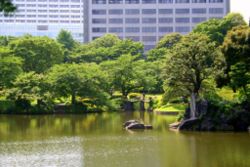
Koishikawa Korakuen Garden
Encyclopedia

Koishikawa
is a locality within Bunkyo, Tokyo. It consists of five sub-areas, . It is located nearby with the same name are two well regarded gardens: the Koishikawa Botanical Garden in Hakusan, and the Koishikawa Korakuen Garden in Korakuen....
, Bunkyō, Tokyo
Bunkyo, Tokyo
is one of the 23 special wards of Tokyo, Japan. Situated in the middle of the ward area, Bunkyō is a residential and educational center. Beginning in the Meiji period, literati like Natsume Sōseki, as well as scholars and politicians have lived there...
, adjacent to Tokyo Dome City
Tokyo Dome City
Tokyo Dome City is an entertainment complex in Bunkyo, Tokyo, Japan.It includes the world's largest roofed baseball stadium known as Tokyo Dome , an amusement park known as Tokyo Dome City Attractions , and Korakuen Hall...
. It is one of two surviving Edo period clan gardens in modern Tokyo, the other being Kyu Shiba Rikyu Garden
Kyu Shiba Rikyu Garden
The , also known as Kyū Shiba Rikyū Onshi Teien is a public garden and former imperial garden in Minato, Tokyo, Japan. The garden is one of two surviving Edo period clan gardens in modern Tokyo, Japan, the other being Koishikawa Kōrakuen Garden in Koishikawa, Bunkyō, Tokyo...
, and one of the oldest and best preserved parks in Tokyo.
The construction was started in 1629 by Tokugawa Yorifusa
Tokugawa Yorifusa
, also known as Mito Yorifusa, was a Japanese daimyo of the early Edo period.- Biography :Known in his childhood as Tsuruchiyomaru, he was the eleventh son of Tokugawa Ieyasu, the first Tokugawa shogun...
, the daimyo
Daimyo
is a generic term referring to the powerful territorial lords in pre-modern Japan who ruled most of the country from their vast, hereditary land holdings...
(feudal lord) of Mito
Mito Domain
was a prominent feudal domain in Japan during the Edo period. Its capital was the city of Mito, and it covered much of present-day Ibaraki Prefecture. Beginning with the appointment of Tokugawa Yorifusa by his father, Shogun Tokugawa Ieyasu, in 1608, the Mito branch of the Tokugawa clan...
han
Han (Japan)
The or domain was the name of the estate belonging to a warrior in Japan after the 17th century. The fiefs of the daimyos of the samurai class of Japan during the Edo period were called han.-Edo period:...
, and was completed by his successor, Tokugawa Mitsukuni
Tokugawa Mitsukuni
or was a prominent daimyo who was known for his influence in the politics of the early Edo period. He was the third son of Tokugawa Yorifusa and succeeded him, becoming the second daimyo of the Mito domain....
.
Mitsukuni named this garden "Kōraku-en" (Kōraku means "enjoying afterwards") after a Chinese teaching of "a governor should worry before people and enjoy after people". The garden shows strong Chinese character in its design, as it was influenced by the West Lake
West Lake
Xī Hú is a famous fresh water lake located in the historic center of Hangzhou, the capital of Zhejiang province in eastern China. The lake is divided by the causeways of Sū Tí , Bái Tí , and Yánggōng Tí...
of Hangzhou
Hangzhou
Hangzhou , formerly transliterated as Hangchow, is the capital and largest city of Zhejiang Province in Eastern China. Governed as a sub-provincial city, and as of 2010, its entire administrative division or prefecture had a registered population of 8.7 million people...
.
Kōrakuen was appointed as a special place of scenic beauty and a special historic site based on the cultural properties protection law of Japan.
All through Japan, there are only seven premises which enjoy double appointments by this Law. They are Kinkakuji, Ginkakuji and Sampo-in of Dogoji in Kyoto
Kyoto
is a city in the central part of the island of Honshū, Japan. It has a population close to 1.5 million. Formerly the imperial capital of Japan, it is now the capital of Kyoto Prefecture, as well as a major part of the Osaka-Kobe-Kyoto metropolitan area.-History:...
, the trace of Nibo-no-miya in the former capital of Heijō-kyō in Nara
Nara, Nara
is the capital city of Nara Prefecture in the Kansai region of Japan. The city occupies the northern part of Nara Prefecture, directly bordering Kyoto Prefecture...
, Itsukushima Shrine
Itsukushima Shrine
Itsukushima Shrine is a Shinto shrine on the island of Itsukushima in the city of Hatsukaichi in Hiroshima Prefecture in Japan...
in Hiroshima
Hiroshima
is the capital of Hiroshima Prefecture, and the largest city in the Chūgoku region of western Honshu, the largest island of Japan. It became best known as the first city in history to be destroyed by a nuclear weapon when the United States Army Air Forces dropped an atomic bomb on it at 8:15 A.M...
and Hamarikyū
Hamarikyu Gardens
is a public park in Chūō, Tokyo, Japan. Located at the mouth of the Sumida River, it was opened April 1, 1946. The park is a 250,165 m² landscaped garden surrounding Shioiri Pond, the park itself surrounded by a seawater moat filled by Tokyo Bay. It was remodeled as a public garden park on the site...
and Kōrakuen in Tokyo.
The park can be accessed by walking from Iidabashi Station
Iidabashi Station
is a major interchange station that straddles Tokyo's Chiyoda, Shinjuku and Bunkyō wards. It was originally built as Iidamachi Station , terminus of the then Kobu railway, precursor to today's Chūō Line. Koishikawa Kōrakuen Garden can be reached by walking from this station...
or Kōrakuen Station
Korakuen Station
is a subway train station in Bunkyō, Tokyo operated by Tokyo Metro. It is directly connected by an underground pedestrian passage to the Toei operated Kasuga Station. It is integrated with the Tokyo Dome City complex and the Bunkyō ward capitol building. Unusually for a subway station, the...
. Regular hours are from 9 in the morning until 5 in the evening. General admission is 300 yen.
See also
External links
- Official website in English

